Project Management: Duplex Feasibility Study and Timeline
VerifiedAdded on 2022/12/26
|16
|2826
|4
Report
AI Summary
This report presents a feasibility study for a residential duplex development project located at 45 Glendon Street, Kingaroy, Australia. The project aims to create both equity and income with a total budget of $800,000 and a construction timeline of nine months. The study includes a project feasibility analysis covering technical, economic, legal, operational, and scheduling feasibility. It also details the project's timeline, constraints (cost, time, and scope), and goals. The report further examines macro and micro environmental business drivers such as economic factors, competition, resources, demographics, technical expertise, time pressure, suppliers, customers, and marketing intermediaries that impact the project's success. The financial analysis reveals a negative equity value, highlighting the importance of careful planning. The project aims to complete the construction work within the approved budget and timeline. The report provides insights into the factors affecting decision-making for construction firms and the strategies needed for success in the Australian construction market.
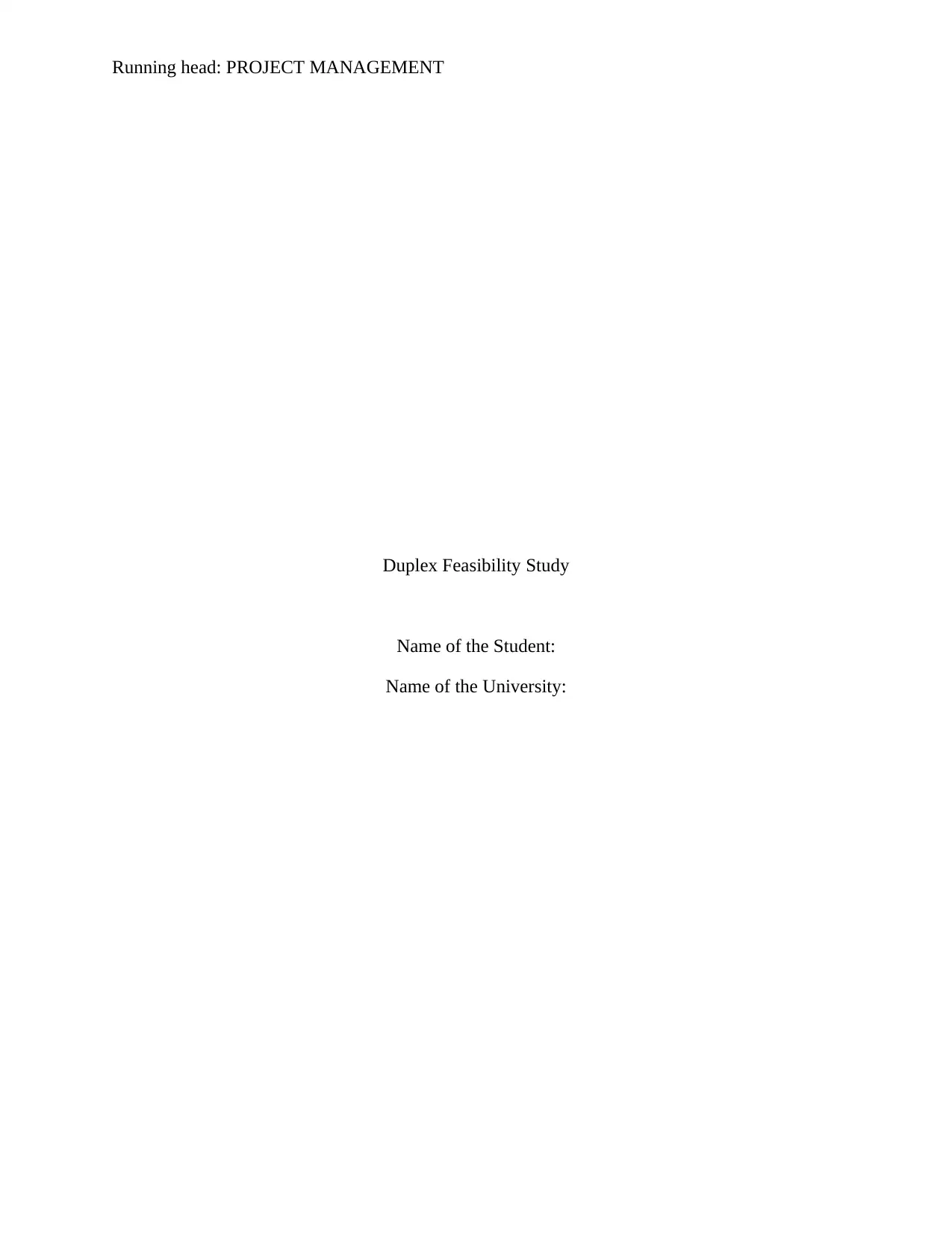
Running head: PROJECT MANAGEMENT
Duplex Feasibility Study
Name of the Student:
Name of the University:
Duplex Feasibility Study
Name of the Student:
Name of the University:
Paraphrase This Document
Need a fresh take? Get an instant paraphrase of this document with our AI Paraphraser
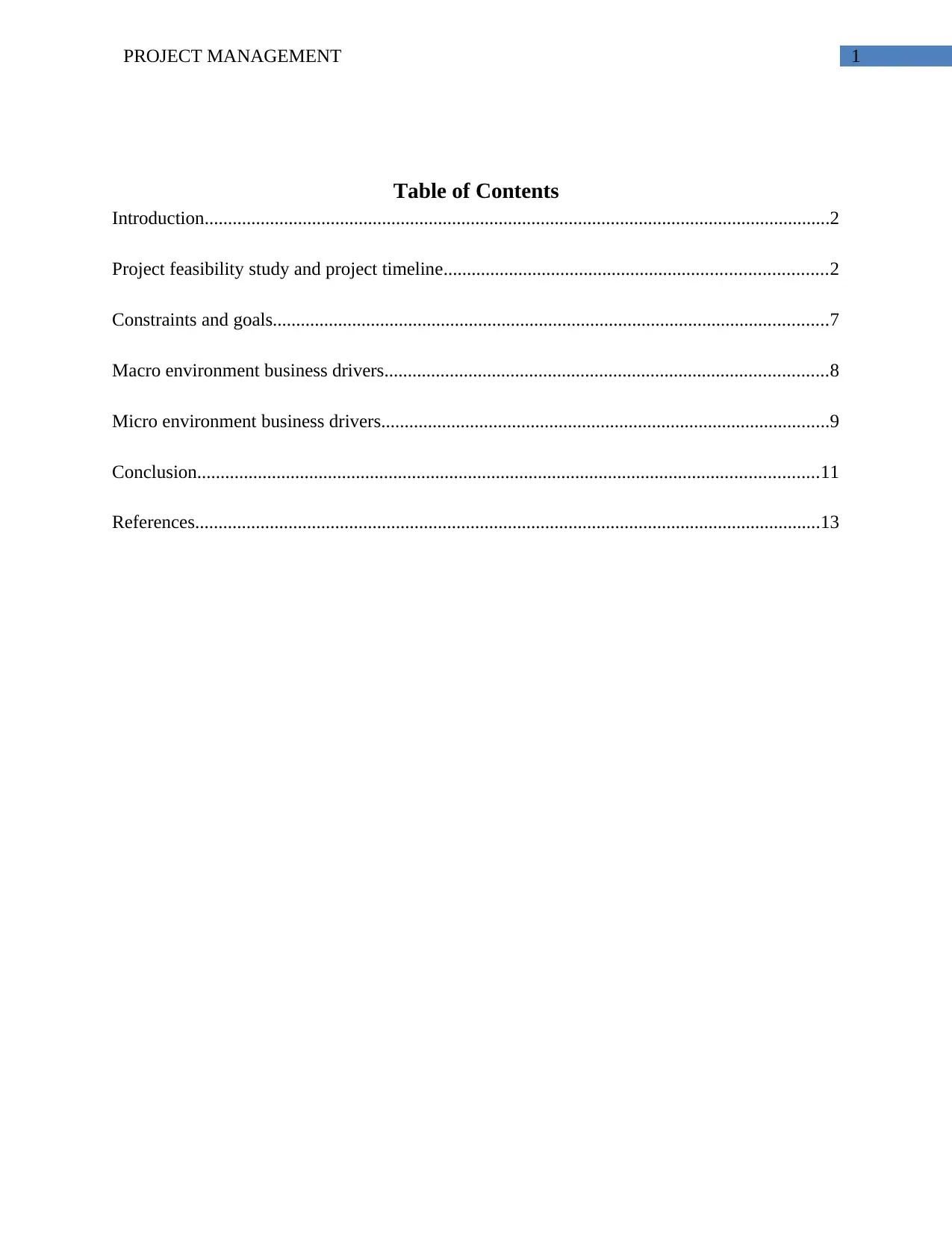
1PROJECT MANAGEMENT
Table of Contents
Introduction......................................................................................................................................2
Project feasibility study and project timeline..................................................................................2
Constraints and goals.......................................................................................................................7
Macro environment business drivers...............................................................................................8
Micro environment business drivers................................................................................................9
Conclusion.....................................................................................................................................11
References......................................................................................................................................13
Table of Contents
Introduction......................................................................................................................................2
Project feasibility study and project timeline..................................................................................2
Constraints and goals.......................................................................................................................7
Macro environment business drivers...............................................................................................8
Micro environment business drivers................................................................................................9
Conclusion.....................................................................................................................................11
References......................................................................................................................................13
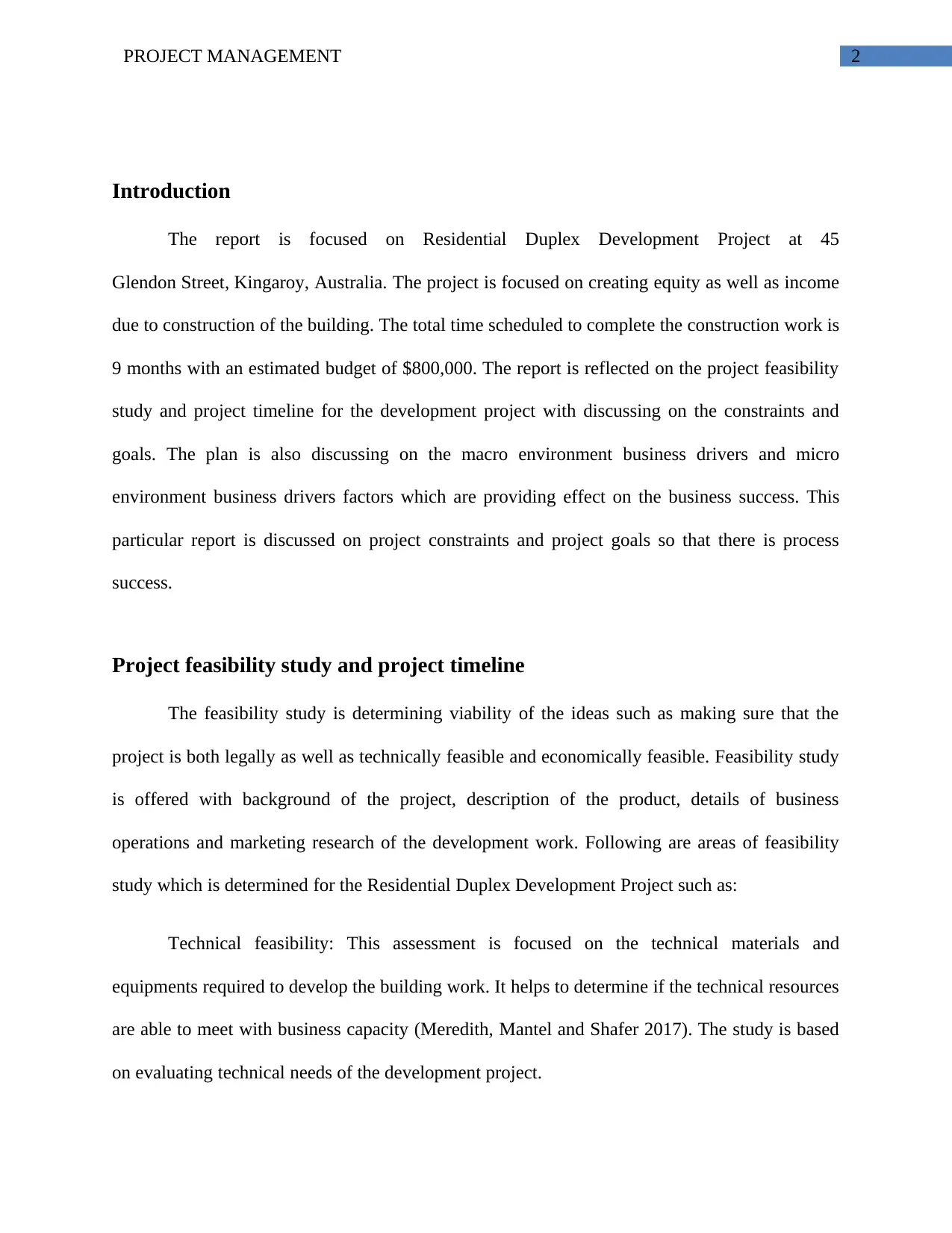
2PROJECT MANAGEMENT
Introduction
The report is focused on Residential Duplex Development Project at 45
Glendon Street, Kingaroy, Australia. The project is focused on creating equity as well as income
due to construction of the building. The total time scheduled to complete the construction work is
9 months with an estimated budget of $800,000. The report is reflected on the project feasibility
study and project timeline for the development project with discussing on the constraints and
goals. The plan is also discussing on the macro environment business drivers and micro
environment business drivers factors which are providing effect on the business success. This
particular report is discussed on project constraints and project goals so that there is process
success.
Project feasibility study and project timeline
The feasibility study is determining viability of the ideas such as making sure that the
project is both legally as well as technically feasible and economically feasible. Feasibility study
is offered with background of the project, description of the product, details of business
operations and marketing research of the development work. Following are areas of feasibility
study which is determined for the Residential Duplex Development Project such as:
Technical feasibility: This assessment is focused on the technical materials and
equipments required to develop the building work. It helps to determine if the technical resources
are able to meet with business capacity (Meredith, Mantel and Shafer 2017). The study is based
on evaluating technical needs of the development project.
Introduction
The report is focused on Residential Duplex Development Project at 45
Glendon Street, Kingaroy, Australia. The project is focused on creating equity as well as income
due to construction of the building. The total time scheduled to complete the construction work is
9 months with an estimated budget of $800,000. The report is reflected on the project feasibility
study and project timeline for the development project with discussing on the constraints and
goals. The plan is also discussing on the macro environment business drivers and micro
environment business drivers factors which are providing effect on the business success. This
particular report is discussed on project constraints and project goals so that there is process
success.
Project feasibility study and project timeline
The feasibility study is determining viability of the ideas such as making sure that the
project is both legally as well as technically feasible and economically feasible. Feasibility study
is offered with background of the project, description of the product, details of business
operations and marketing research of the development work. Following are areas of feasibility
study which is determined for the Residential Duplex Development Project such as:
Technical feasibility: This assessment is focused on the technical materials and
equipments required to develop the building work. It helps to determine if the technical resources
are able to meet with business capacity (Meredith, Mantel and Shafer 2017). The study is based
on evaluating technical needs of the development project.
⊘ This is a preview!⊘
Do you want full access?
Subscribe today to unlock all pages.

Trusted by 1+ million students worldwide
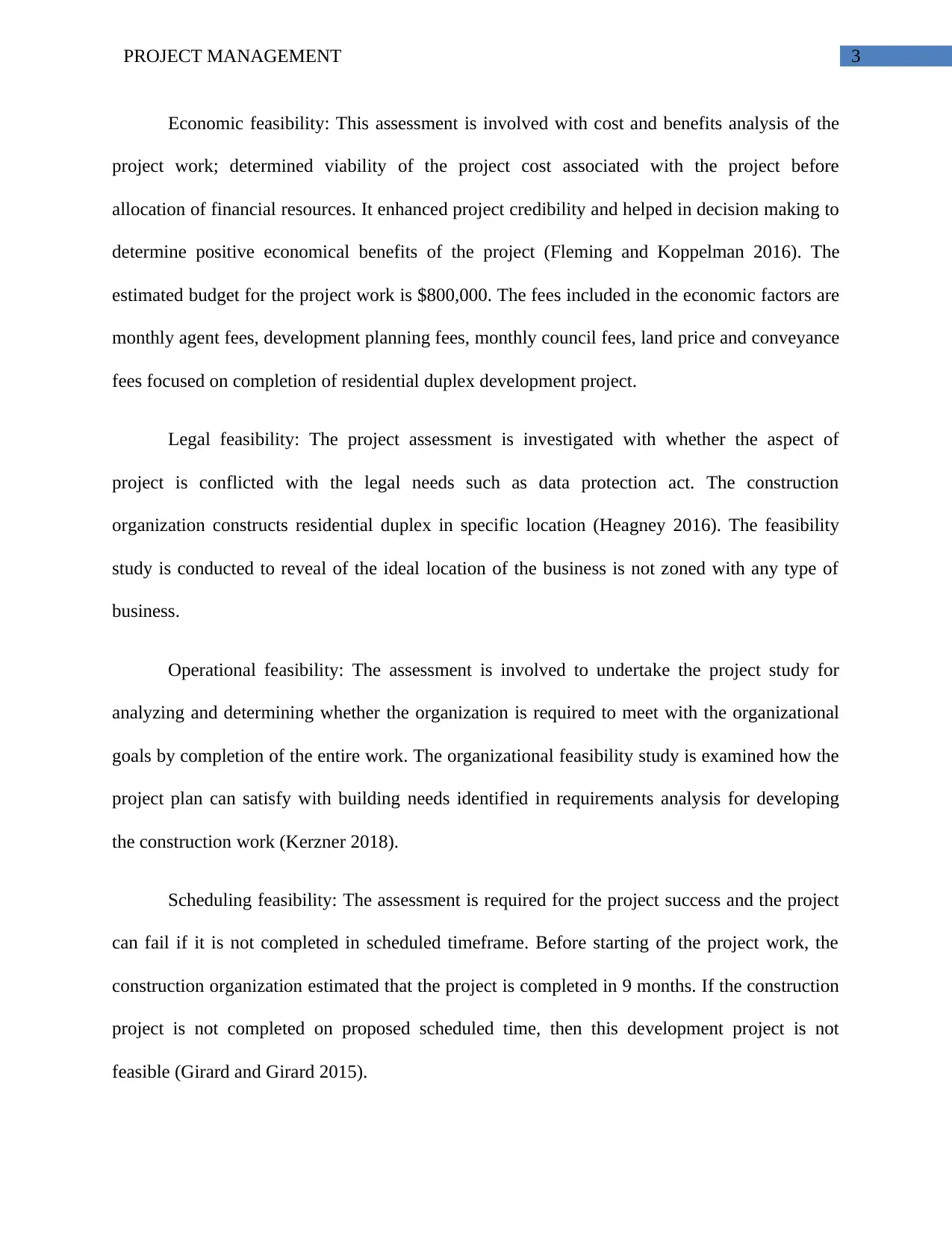
3PROJECT MANAGEMENT
Economic feasibility: This assessment is involved with cost and benefits analysis of the
project work; determined viability of the project cost associated with the project before
allocation of financial resources. It enhanced project credibility and helped in decision making to
determine positive economical benefits of the project (Fleming and Koppelman 2016). The
estimated budget for the project work is $800,000. The fees included in the economic factors are
monthly agent fees, development planning fees, monthly council fees, land price and conveyance
fees focused on completion of residential duplex development project.
Legal feasibility: The project assessment is investigated with whether the aspect of
project is conflicted with the legal needs such as data protection act. The construction
organization constructs residential duplex in specific location (Heagney 2016). The feasibility
study is conducted to reveal of the ideal location of the business is not zoned with any type of
business.
Operational feasibility: The assessment is involved to undertake the project study for
analyzing and determining whether the organization is required to meet with the organizational
goals by completion of the entire work. The organizational feasibility study is examined how the
project plan can satisfy with building needs identified in requirements analysis for developing
the construction work (Kerzner 2018).
Scheduling feasibility: The assessment is required for the project success and the project
can fail if it is not completed in scheduled timeframe. Before starting of the project work, the
construction organization estimated that the project is completed in 9 months. If the construction
project is not completed on proposed scheduled time, then this development project is not
feasible (Girard and Girard 2015).
Economic feasibility: This assessment is involved with cost and benefits analysis of the
project work; determined viability of the project cost associated with the project before
allocation of financial resources. It enhanced project credibility and helped in decision making to
determine positive economical benefits of the project (Fleming and Koppelman 2016). The
estimated budget for the project work is $800,000. The fees included in the economic factors are
monthly agent fees, development planning fees, monthly council fees, land price and conveyance
fees focused on completion of residential duplex development project.
Legal feasibility: The project assessment is investigated with whether the aspect of
project is conflicted with the legal needs such as data protection act. The construction
organization constructs residential duplex in specific location (Heagney 2016). The feasibility
study is conducted to reveal of the ideal location of the business is not zoned with any type of
business.
Operational feasibility: The assessment is involved to undertake the project study for
analyzing and determining whether the organization is required to meet with the organizational
goals by completion of the entire work. The organizational feasibility study is examined how the
project plan can satisfy with building needs identified in requirements analysis for developing
the construction work (Kerzner 2018).
Scheduling feasibility: The assessment is required for the project success and the project
can fail if it is not completed in scheduled timeframe. Before starting of the project work, the
construction organization estimated that the project is completed in 9 months. If the construction
project is not completed on proposed scheduled time, then this development project is not
feasible (Girard and Girard 2015).
Paraphrase This Document
Need a fresh take? Get an instant paraphrase of this document with our AI Paraphraser
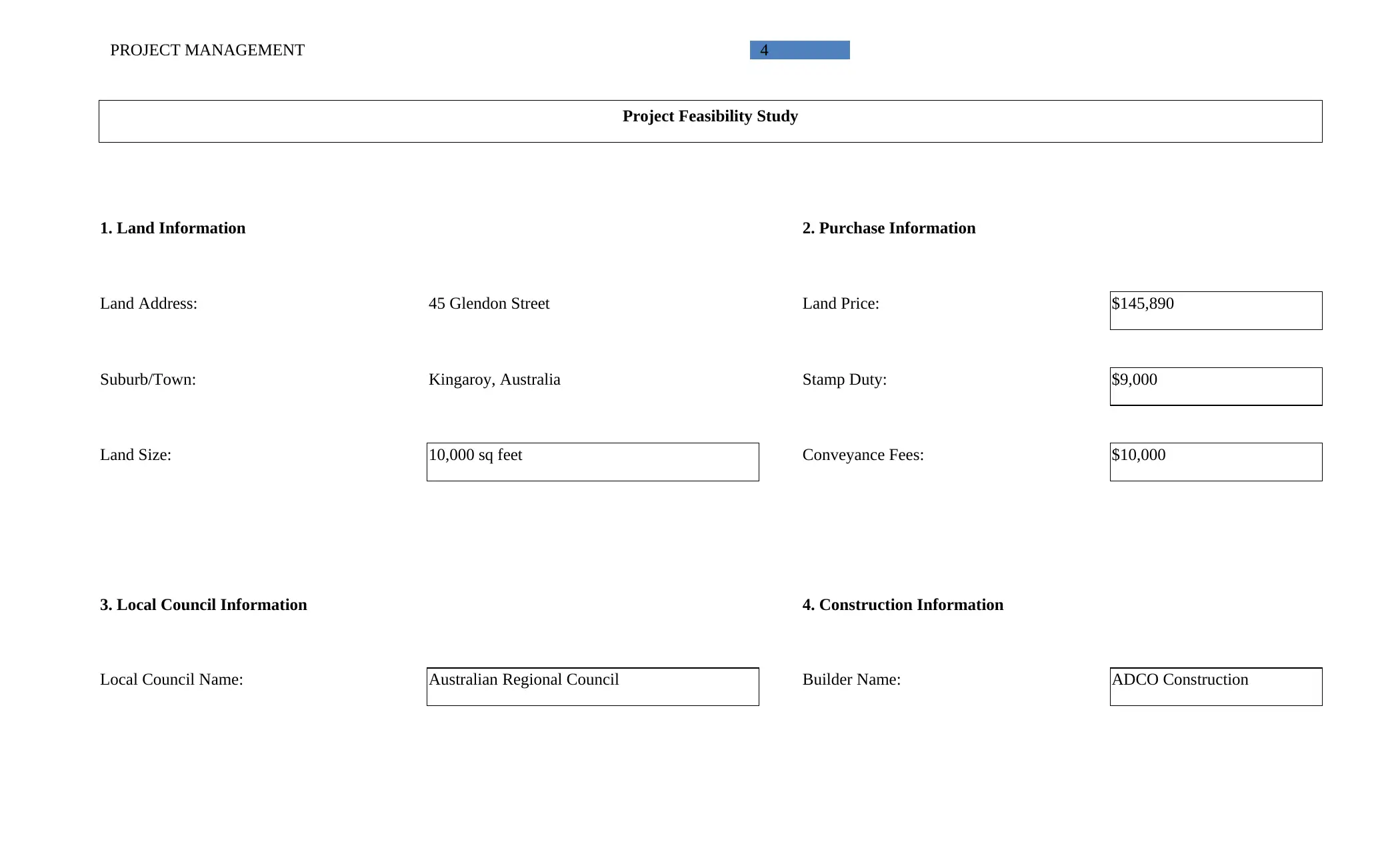
4PROJECT MANAGEMENT
Project Feasibility Study
1. Land Information 2. Purchase Information
Land Address: 45 Glendon Street Land Price: $145,890
Suburb/Town: Kingaroy, Australia Stamp Duty: $9,000
Land Size: 10,000 sq feet Conveyance Fees: $10,000
3. Local Council Information 4. Construction Information
Local Council Name: Australian Regional Council Builder Name: ADCO Construction
Project Feasibility Study
1. Land Information 2. Purchase Information
Land Address: 45 Glendon Street Land Price: $145,890
Suburb/Town: Kingaroy, Australia Stamp Duty: $9,000
Land Size: 10,000 sq feet Conveyance Fees: $10,000
3. Local Council Information 4. Construction Information
Local Council Name: Australian Regional Council Builder Name: ADCO Construction
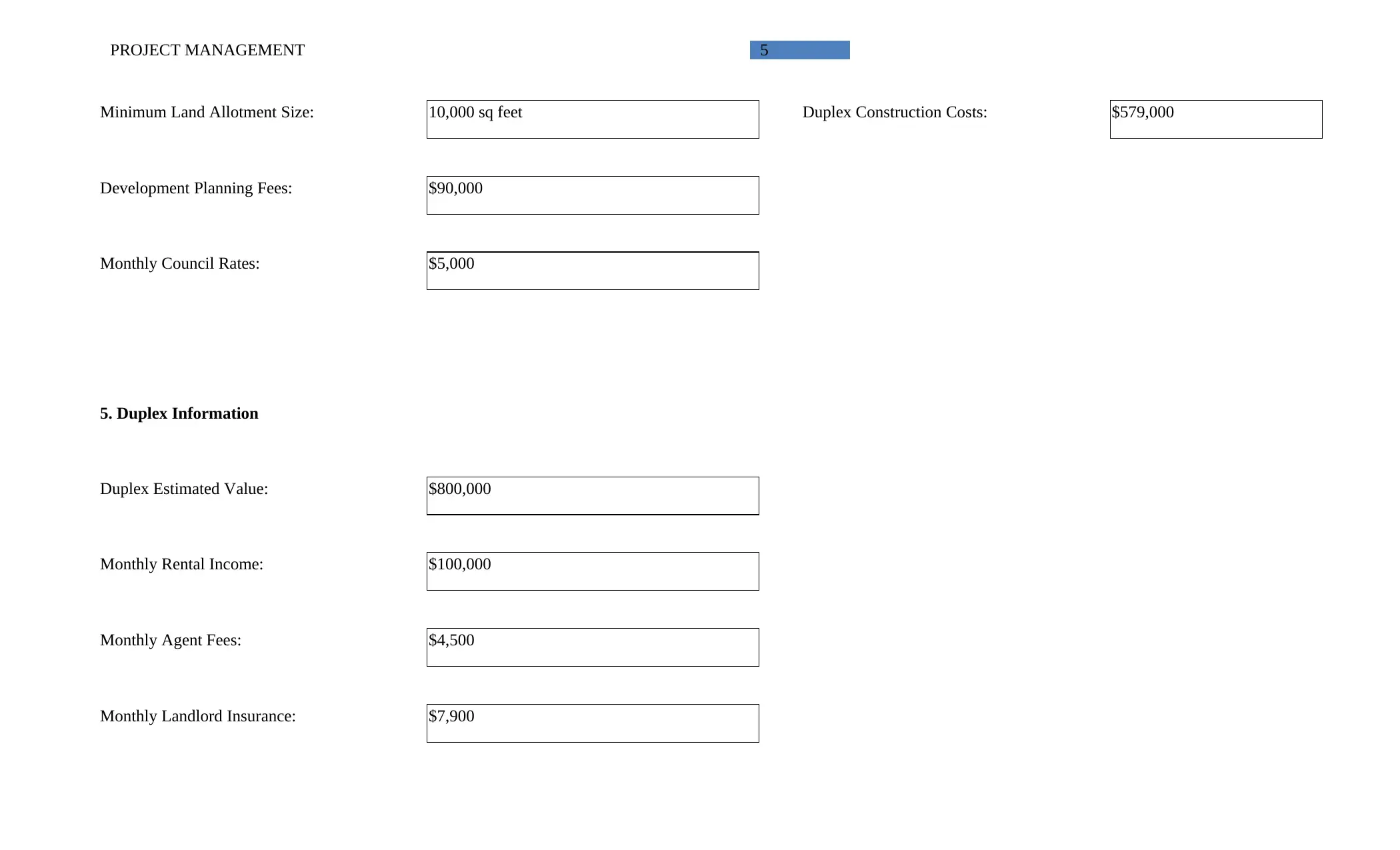
5PROJECT MANAGEMENT
Minimum Land Allotment Size: 10,000 sq feet Duplex Construction Costs: $579,000
Development Planning Fees: $90,000
Monthly Council Rates: $5,000
5. Duplex Information
Duplex Estimated Value: $800,000
Monthly Rental Income: $100,000
Monthly Agent Fees: $4,500
Monthly Landlord Insurance: $7,900
Minimum Land Allotment Size: 10,000 sq feet Duplex Construction Costs: $579,000
Development Planning Fees: $90,000
Monthly Council Rates: $5,000
5. Duplex Information
Duplex Estimated Value: $800,000
Monthly Rental Income: $100,000
Monthly Agent Fees: $4,500
Monthly Landlord Insurance: $7,900
⊘ This is a preview!⊘
Do you want full access?
Subscribe today to unlock all pages.

Trusted by 1+ million students worldwide
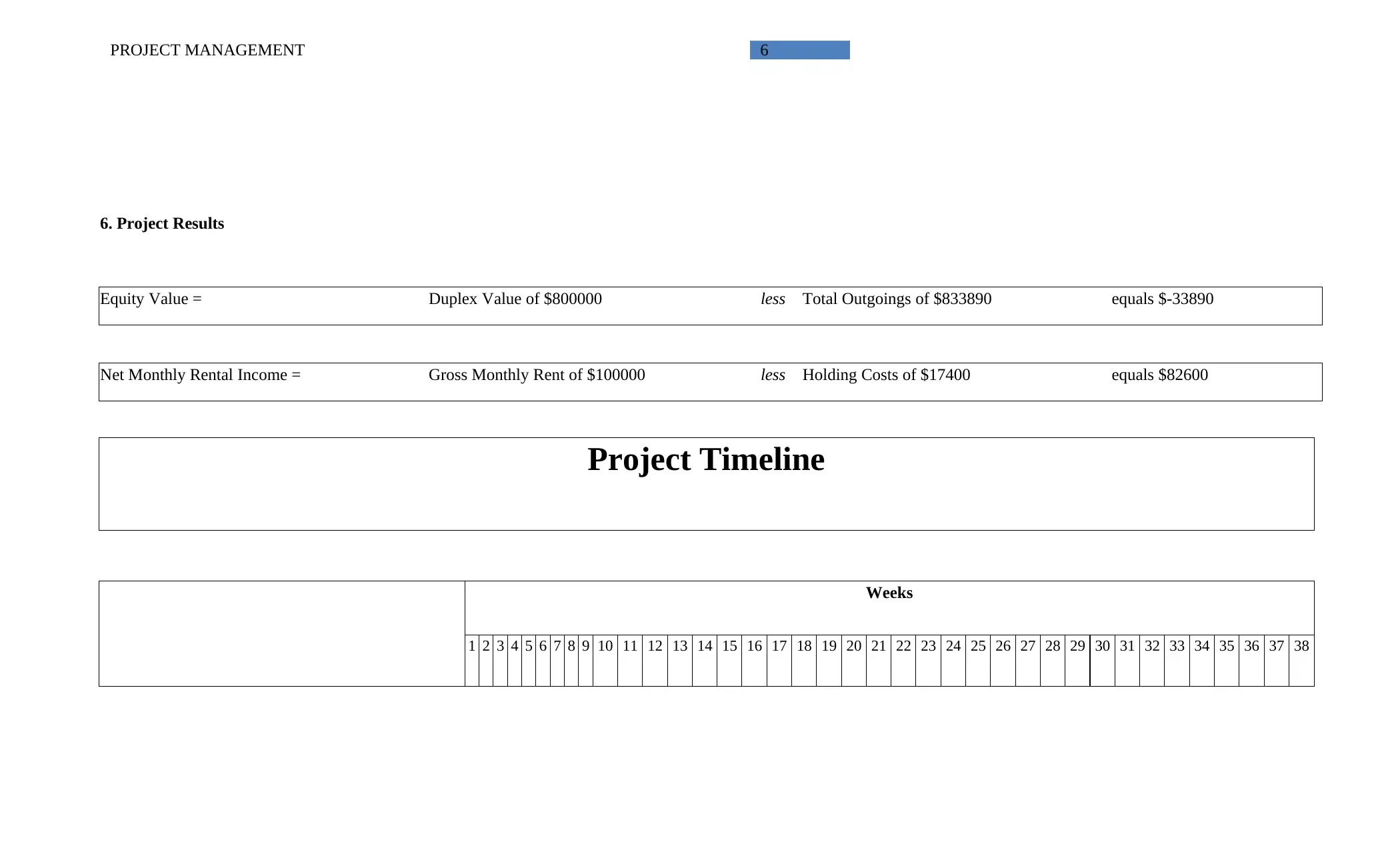
6PROJECT MANAGEMENT
6. Project Results
Equity Value = Duplex Value of $800000 less Total Outgoings of $833890 equals $-33890
Net Monthly Rental Income = Gross Monthly Rent of $100000 less Holding Costs of $17400 equals $82600
Project Timeline
Weeks
1 2 3 4 5 6 7 8 9 10 11 12 13 14 15 16 17 18 19 20 21 22 23 24 25 26 27 28 29 30 31 32 33 34 35 36 37 38
6. Project Results
Equity Value = Duplex Value of $800000 less Total Outgoings of $833890 equals $-33890
Net Monthly Rental Income = Gross Monthly Rent of $100000 less Holding Costs of $17400 equals $82600
Project Timeline
Weeks
1 2 3 4 5 6 7 8 9 10 11 12 13 14 15 16 17 18 19 20 21 22 23 24 25 26 27 28 29 30 31 32 33 34 35 36 37 38
Paraphrase This Document
Need a fresh take? Get an instant paraphrase of this document with our AI Paraphraser
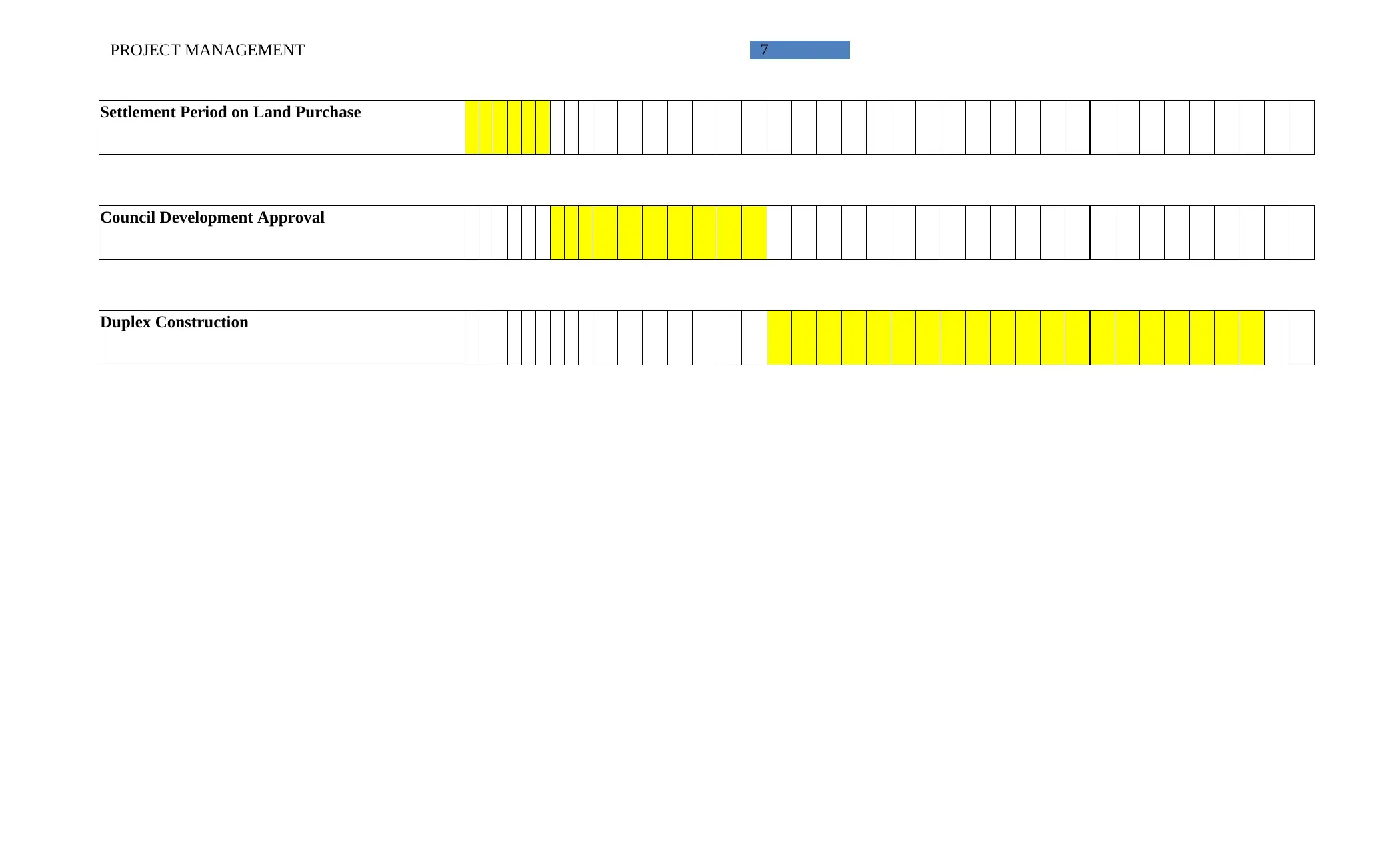
7PROJECT MANAGEMENT
Settlement Period on Land Purchase
Council Development Approval
Duplex Construction
Settlement Period on Land Purchase
Council Development Approval
Duplex Construction
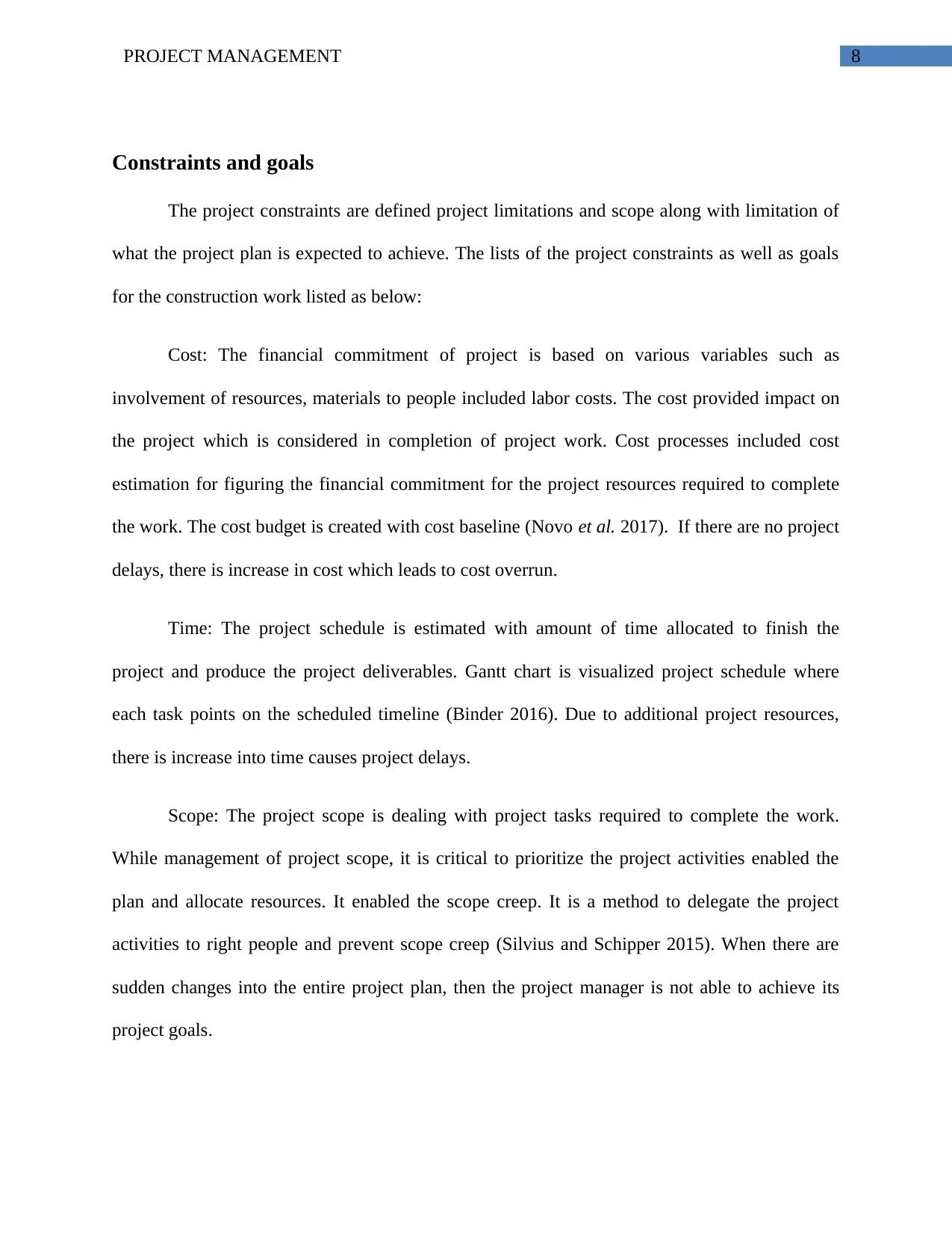
8PROJECT MANAGEMENT
Constraints and goals
The project constraints are defined project limitations and scope along with limitation of
what the project plan is expected to achieve. The lists of the project constraints as well as goals
for the construction work listed as below:
Cost: The financial commitment of project is based on various variables such as
involvement of resources, materials to people included labor costs. The cost provided impact on
the project which is considered in completion of project work. Cost processes included cost
estimation for figuring the financial commitment for the project resources required to complete
the work. The cost budget is created with cost baseline (Novo et al. 2017). If there are no project
delays, there is increase in cost which leads to cost overrun.
Time: The project schedule is estimated with amount of time allocated to finish the
project and produce the project deliverables. Gantt chart is visualized project schedule where
each task points on the scheduled timeline (Binder 2016). Due to additional project resources,
there is increase into time causes project delays.
Scope: The project scope is dealing with project tasks required to complete the work.
While management of project scope, it is critical to prioritize the project activities enabled the
plan and allocate resources. It enabled the scope creep. It is a method to delegate the project
activities to right people and prevent scope creep (Silvius and Schipper 2015). When there are
sudden changes into the entire project plan, then the project manager is not able to achieve its
project goals.
Constraints and goals
The project constraints are defined project limitations and scope along with limitation of
what the project plan is expected to achieve. The lists of the project constraints as well as goals
for the construction work listed as below:
Cost: The financial commitment of project is based on various variables such as
involvement of resources, materials to people included labor costs. The cost provided impact on
the project which is considered in completion of project work. Cost processes included cost
estimation for figuring the financial commitment for the project resources required to complete
the work. The cost budget is created with cost baseline (Novo et al. 2017). If there are no project
delays, there is increase in cost which leads to cost overrun.
Time: The project schedule is estimated with amount of time allocated to finish the
project and produce the project deliverables. Gantt chart is visualized project schedule where
each task points on the scheduled timeline (Binder 2016). Due to additional project resources,
there is increase into time causes project delays.
Scope: The project scope is dealing with project tasks required to complete the work.
While management of project scope, it is critical to prioritize the project activities enabled the
plan and allocate resources. It enabled the scope creep. It is a method to delegate the project
activities to right people and prevent scope creep (Silvius and Schipper 2015). When there are
sudden changes into the entire project plan, then the project manager is not able to achieve its
project goals.
⊘ This is a preview!⊘
Do you want full access?
Subscribe today to unlock all pages.

Trusted by 1+ million students worldwide
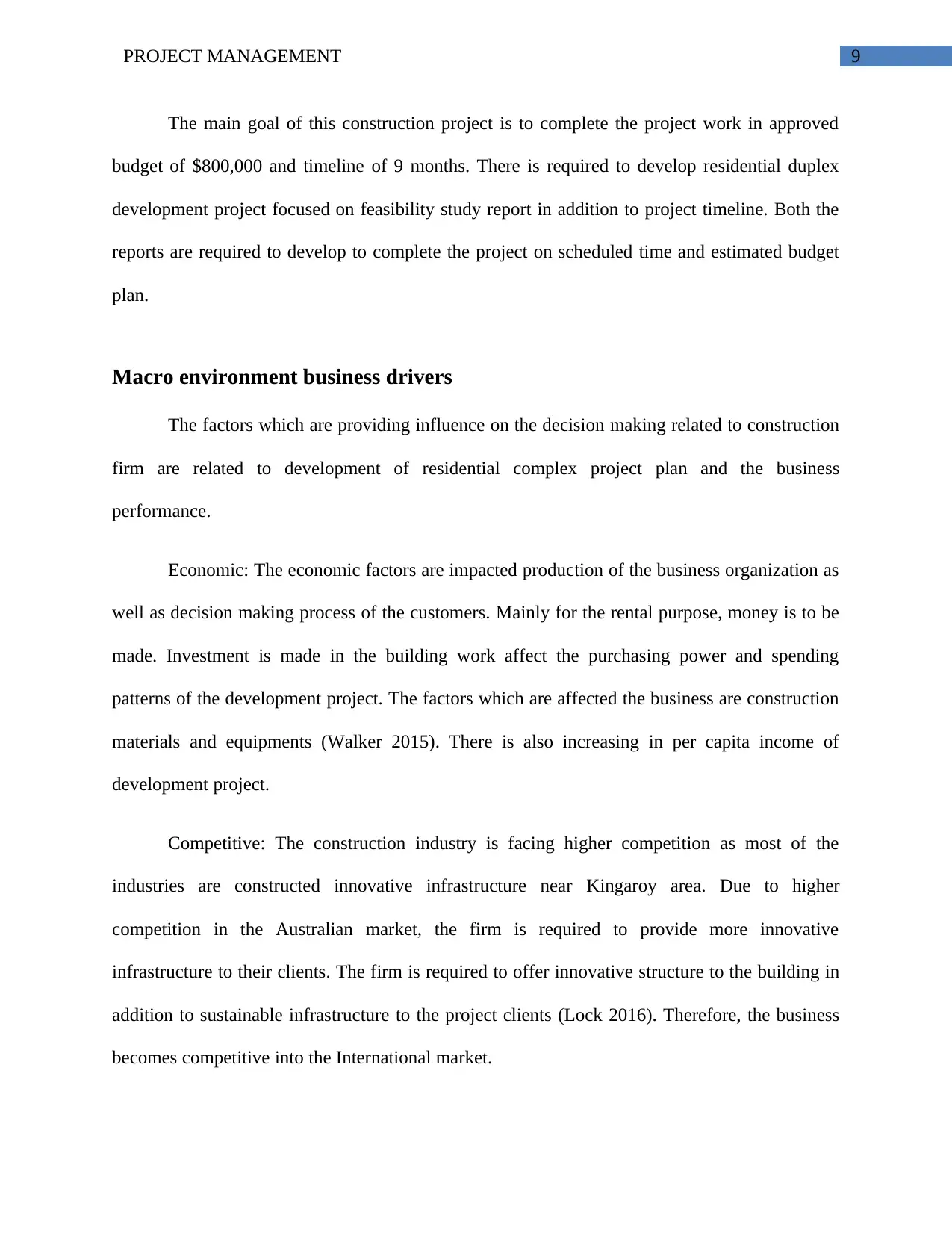
9PROJECT MANAGEMENT
The main goal of this construction project is to complete the project work in approved
budget of $800,000 and timeline of 9 months. There is required to develop residential duplex
development project focused on feasibility study report in addition to project timeline. Both the
reports are required to develop to complete the project on scheduled time and estimated budget
plan.
Macro environment business drivers
The factors which are providing influence on the decision making related to construction
firm are related to development of residential complex project plan and the business
performance.
Economic: The economic factors are impacted production of the business organization as
well as decision making process of the customers. Mainly for the rental purpose, money is to be
made. Investment is made in the building work affect the purchasing power and spending
patterns of the development project. The factors which are affected the business are construction
materials and equipments (Walker 2015). There is also increasing in per capita income of
development project.
Competitive: The construction industry is facing higher competition as most of the
industries are constructed innovative infrastructure near Kingaroy area. Due to higher
competition in the Australian market, the firm is required to provide more innovative
infrastructure to their clients. The firm is required to offer innovative structure to the building in
addition to sustainable infrastructure to the project clients (Lock 2016). Therefore, the business
becomes competitive into the International market.
The main goal of this construction project is to complete the project work in approved
budget of $800,000 and timeline of 9 months. There is required to develop residential duplex
development project focused on feasibility study report in addition to project timeline. Both the
reports are required to develop to complete the project on scheduled time and estimated budget
plan.
Macro environment business drivers
The factors which are providing influence on the decision making related to construction
firm are related to development of residential complex project plan and the business
performance.
Economic: The economic factors are impacted production of the business organization as
well as decision making process of the customers. Mainly for the rental purpose, money is to be
made. Investment is made in the building work affect the purchasing power and spending
patterns of the development project. The factors which are affected the business are construction
materials and equipments (Walker 2015). There is also increasing in per capita income of
development project.
Competitive: The construction industry is facing higher competition as most of the
industries are constructed innovative infrastructure near Kingaroy area. Due to higher
competition in the Australian market, the firm is required to provide more innovative
infrastructure to their clients. The firm is required to offer innovative structure to the building in
addition to sustainable infrastructure to the project clients (Lock 2016). Therefore, the business
becomes competitive into the International market.
Paraphrase This Document
Need a fresh take? Get an instant paraphrase of this document with our AI Paraphraser
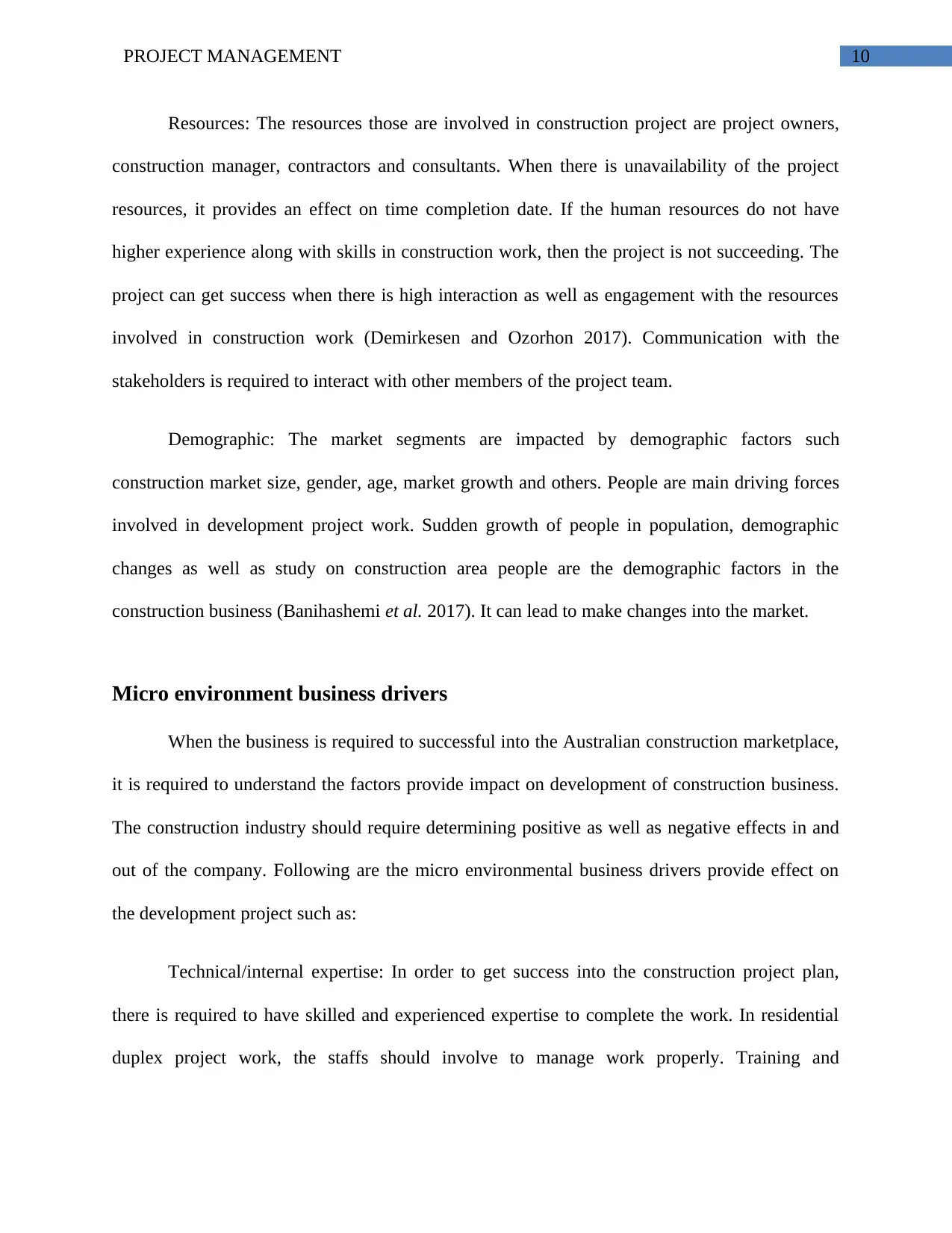
10PROJECT MANAGEMENT
Resources: The resources those are involved in construction project are project owners,
construction manager, contractors and consultants. When there is unavailability of the project
resources, it provides an effect on time completion date. If the human resources do not have
higher experience along with skills in construction work, then the project is not succeeding. The
project can get success when there is high interaction as well as engagement with the resources
involved in construction work (Demirkesen and Ozorhon 2017). Communication with the
stakeholders is required to interact with other members of the project team.
Demographic: The market segments are impacted by demographic factors such
construction market size, gender, age, market growth and others. People are main driving forces
involved in development project work. Sudden growth of people in population, demographic
changes as well as study on construction area people are the demographic factors in the
construction business (Banihashemi et al. 2017). It can lead to make changes into the market.
Micro environment business drivers
When the business is required to successful into the Australian construction marketplace,
it is required to understand the factors provide impact on development of construction business.
The construction industry should require determining positive as well as negative effects in and
out of the company. Following are the micro environmental business drivers provide effect on
the development project such as:
Technical/internal expertise: In order to get success into the construction project plan,
there is required to have skilled and experienced expertise to complete the work. In residential
duplex project work, the staffs should involve to manage work properly. Training and
Resources: The resources those are involved in construction project are project owners,
construction manager, contractors and consultants. When there is unavailability of the project
resources, it provides an effect on time completion date. If the human resources do not have
higher experience along with skills in construction work, then the project is not succeeding. The
project can get success when there is high interaction as well as engagement with the resources
involved in construction work (Demirkesen and Ozorhon 2017). Communication with the
stakeholders is required to interact with other members of the project team.
Demographic: The market segments are impacted by demographic factors such
construction market size, gender, age, market growth and others. People are main driving forces
involved in development project work. Sudden growth of people in population, demographic
changes as well as study on construction area people are the demographic factors in the
construction business (Banihashemi et al. 2017). It can lead to make changes into the market.
Micro environment business drivers
When the business is required to successful into the Australian construction marketplace,
it is required to understand the factors provide impact on development of construction business.
The construction industry should require determining positive as well as negative effects in and
out of the company. Following are the micro environmental business drivers provide effect on
the development project such as:
Technical/internal expertise: In order to get success into the construction project plan,
there is required to have skilled and experienced expertise to complete the work. In residential
duplex project work, the staffs should involve to manage work properly. Training and
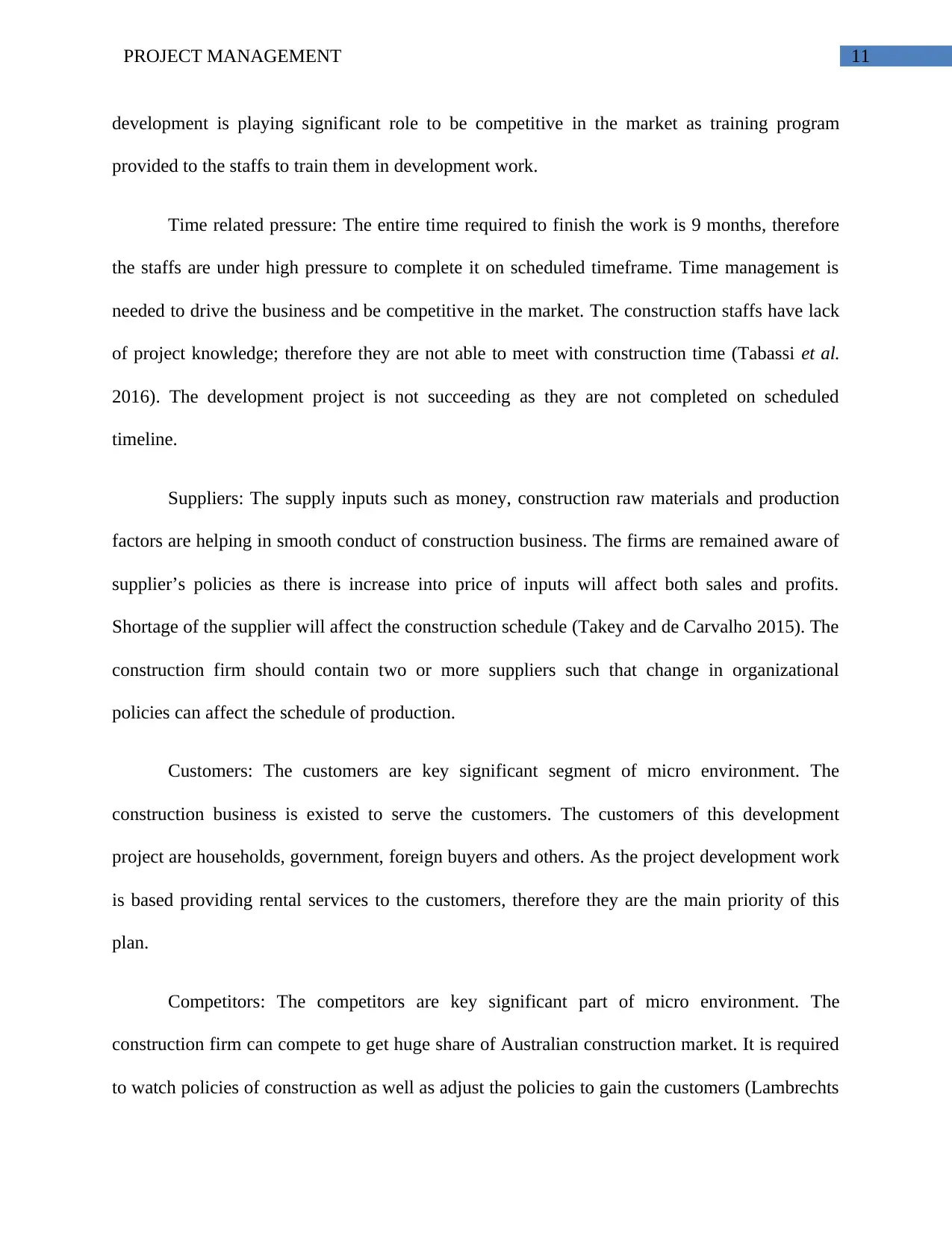
11PROJECT MANAGEMENT
development is playing significant role to be competitive in the market as training program
provided to the staffs to train them in development work.
Time related pressure: The entire time required to finish the work is 9 months, therefore
the staffs are under high pressure to complete it on scheduled timeframe. Time management is
needed to drive the business and be competitive in the market. The construction staffs have lack
of project knowledge; therefore they are not able to meet with construction time (Tabassi et al.
2016). The development project is not succeeding as they are not completed on scheduled
timeline.
Suppliers: The supply inputs such as money, construction raw materials and production
factors are helping in smooth conduct of construction business. The firms are remained aware of
supplier’s policies as there is increase into price of inputs will affect both sales and profits.
Shortage of the supplier will affect the construction schedule (Takey and de Carvalho 2015). The
construction firm should contain two or more suppliers such that change in organizational
policies can affect the schedule of production.
Customers: The customers are key significant segment of micro environment. The
construction business is existed to serve the customers. The customers of this development
project are households, government, foreign buyers and others. As the project development work
is based providing rental services to the customers, therefore they are the main priority of this
plan.
Competitors: The competitors are key significant part of micro environment. The
construction firm can compete to get huge share of Australian construction market. It is required
to watch policies of construction as well as adjust the policies to gain the customers (Lambrechts
development is playing significant role to be competitive in the market as training program
provided to the staffs to train them in development work.
Time related pressure: The entire time required to finish the work is 9 months, therefore
the staffs are under high pressure to complete it on scheduled timeframe. Time management is
needed to drive the business and be competitive in the market. The construction staffs have lack
of project knowledge; therefore they are not able to meet with construction time (Tabassi et al.
2016). The development project is not succeeding as they are not completed on scheduled
timeline.
Suppliers: The supply inputs such as money, construction raw materials and production
factors are helping in smooth conduct of construction business. The firms are remained aware of
supplier’s policies as there is increase into price of inputs will affect both sales and profits.
Shortage of the supplier will affect the construction schedule (Takey and de Carvalho 2015). The
construction firm should contain two or more suppliers such that change in organizational
policies can affect the schedule of production.
Customers: The customers are key significant segment of micro environment. The
construction business is existed to serve the customers. The customers of this development
project are households, government, foreign buyers and others. As the project development work
is based providing rental services to the customers, therefore they are the main priority of this
plan.
Competitors: The competitors are key significant part of micro environment. The
construction firm can compete to get huge share of Australian construction market. It is required
to watch policies of construction as well as adjust the policies to gain the customers (Lambrechts
⊘ This is a preview!⊘
Do you want full access?
Subscribe today to unlock all pages.

Trusted by 1+ million students worldwide
1 out of 16
Related Documents
Your All-in-One AI-Powered Toolkit for Academic Success.
+13062052269
info@desklib.com
Available 24*7 on WhatsApp / Email
![[object Object]](/_next/static/media/star-bottom.7253800d.svg)
Unlock your academic potential
Copyright © 2020–2025 A2Z Services. All Rights Reserved. Developed and managed by ZUCOL.





